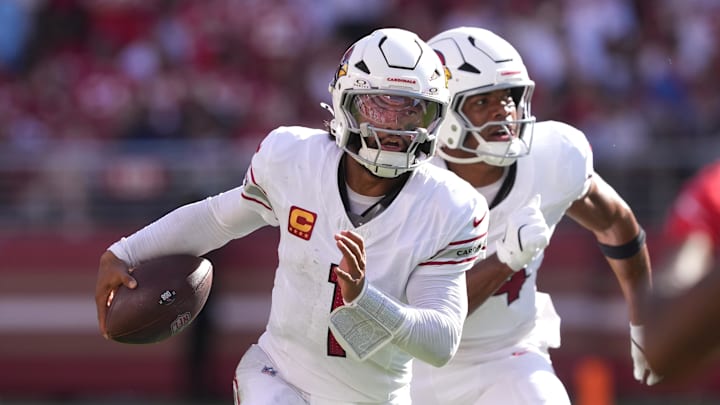Kyler Murray Is Becoming the Player He and the Cardinals Believed He Would Be

It’s time to consider Kyler Murray the way most once considered him—a No. 1 pick, explosive in speed, teeming with athleticism and elite in arm talent. That was Murray, a franchise cornerstone poised to join and compete with the best quarterbacks in the NFL. Which was before, well, everything else, five bumpy seasons at best.
Murray delivered more proof in Week 5, only minutes into his Arizona Cardinals’ matchup with the San Francisco 49ers. Off he went, early into the first quarter, on a designed run. He scooted right, sped up and shot between two defenders locked up by his blockers. And he knew, right then, with 40 yards of empty green turf ahead, that he would score. Murray threw up his right arm—sort of a half fist pump—at the Niners’ 40-yard-line. By the time he reached the 5, he was in celebration mode.
“OH! OHHHHH!”
That was the analysis on Fox’s broadcast. It wouldn’t have been noteworthy if not for the analyst who delivered it, Tom Brady, the greatest quarterback ever.
Perhaps Brady’s childlike exuberance owed to his career tally of rushing touchdowns—just 28—the vast majority of which came on quarterback plunges near the goal line. More likely: Brady was just like everyone else who spied Murray’s continued transformation in real time. Someone who loves football, and someone who recognized something that doesn’t happen every Sunday.
Someone who saw, in Murray, a player who has moved beyond the injuries, the insults, and the narratives that clouded his first five seasons. Who’s moving toward becoming the player he and Arizona believed he would be—and sometimes has been—all along.
After creating a come-from-behind 24–23 victory over a preseason Super Bowl favorite (the Cardinals trailed 23–10 at halftime), on the road, in a pivotal division game, Murray found his counterpart, Brock Purdy, near midfield. They shared a few words and a quick embrace. But that moment, short and seemingly benign, actually came packed with poignancy. It wasn’t game recognize game. More like: maligned recognized maligned, from two quarterbacks who understand that opinions shape no more than interest in the NFL.
This week, after a win that saved the early portion of Arizona’s season, Murray announced a marketing partnership on his social media channels. His chosen words, in both written and audible forms, were laced with significance, just like that weary, tender postgame huddle. Murray would stump for the video game Call of Duty, and he would stump for this particular video game because of the “everything else” above.
First, some context: Murray won league Offensive Rookie of the Year honors in his first season, 2019; in ’20 and ’21, he improved his accuracy and lit up desert scoreboards with a parade of touchdowns. During the ’22 offseason, he signed the kind of contract extension—five years, up to $230.5 million, with $103.3 million guaranteed the second he put pen to paper—that can set up a franchise … or topple it. In earlier versions of the contract, the franchise had added a clause that would stick to Murray like epoxy glue. Arizona executives called it an “independent study addendum,” and, while the phrasing was made more palatable intentionally, the clause itself stood in stark contrast to how the Cardinals would eventually explain its utility. The clause required Murray to immerse himself in studying game film for at least four hours each week.
It also included a clause within a clause: That he could not watch TV, or play video games, during those hours. In other words, Arizona wanted to pay Murray to do a basic part of an NFL quarterback’s job, and the Cardinals not only wanted to pay for that, but they wanted to make it explicit. All of that could only lead to one conclusion: That they, the people who would know best, didn’t believe Murray studied enough to realize his vast potential. This notion is bolstered by another, more sinister, related sign. How do you think the story went public in the first place?
In public, Murray tried to laugh the whole thing off. He did say he found the addendum, which was not in the deal that he signed, disrespectful, “almost a joke.” The Cardinals tried to play down the implications in the news and how it became news. Nobody seemed to buy those explanations, especially their star quarterback, who told ESPN that he turned to video games as an outlet to relieve stress.
Those who wanted to criticize Murray took the sentiments the team had handed him and amplified all criticism. Many utilized his affinity for one game in particular. Yup, Call of Duty. Hence the partnership. And the first sentence he wrote on X to announce it: To the trolls who memed me into a bag, thank you!
Fair enough. Murray told a nation of football addicts before the season what was coming. He had torn his ACL on Dec. 12, 2022, during a Monday Night Football game against the New England Patriots, shelving him for the rest of that season and part of last year. He played in eight games in ’23, pushed the Cardinals to three of their four wins, and did all that after surgery while adjusting to a new regime and dodging the memes still being made in his honor. Just add “dis” in front.
Yet, there he was this spring and summer, standing before journalists in Arizona, hinting at all that was to come. He detailed the offense’s improvements, starting with the year of experience all returning players had in a new offensive system; everyone was faster and more comfortable, and limits of what was possible were being raised weekly. He didn’t see a ceiling. He believed the Cardinals could win their first Super Bowl in franchise history, at least since the move to Arizona in 1988. He pronounced his leg healthy and noted the offseason he had to improve in contrast with the previous one.
All factors created what Murray described as a natural maturation. “Hell, yeah, I’m excited,” he said then.
Did anyone believe him?
Surely, some supported Murray. It’s not like “bust” would be an accurate description of his first five seasons. He had made two Pro Bowls, had passed for 94 touchdowns and rushed for 26, and had shown off his cannon that launched passes and that speed.
Could he elevate from there? That was the better question.
He did. He has. In Week 2, Murray played a flawless football game, if such a thing exists: 81% completion accuracy, three touchdown passes, 59 rushing
yards, maxed-out passer rating and no picks. The Cardinals bludgeoned the Los Angeles Rams, 41–10. He might have been the only Cardinal who played well in Week 4, a 42–14 defeat to the Washington Commanders.
Each week, Murray put more and more of his wide array of talents together. He passed with increasingly better accuracy. He threw deep. He made smart, shorter throws when deep attempts weren’t available. He hadn’t run much until the Niners game, when he picked up 83 yards and wowed Brady in the process. One scramble pushed Arizona into field goal range for the game-winning kick. It came at the end of a 14-play drive, which was as methodical as the opening score was thrilling.
At this point, Murray exists in the All Things Are True Space. His Call of Duty announcement-victory lap might indeed have been a tad premature. His completion percentage (68.1) ranks as the second highest of his career, but he’s still 13th in the NFL in that category. He didn’t play particularly well, despite obvious improvements, in losses to the Buffalo Bills and Detroit Lions. He ranks ninth in passer rating (99.1), which is good, really good, but not No. 1 pick good.
It’s also true that Murray and Arizona appear to be solidifying an identity, which the franchise has lacked for longer than anyone there would admit publicly. The Cardinals, behind Murray and James Conner, can run the ball. Their offensive line is elite. They have, at times, with limited talent, played defense at high levels. Most pundits believe they will improve as the season chugs along.
And, yes, the NFC West indeed appears ripe for some chaos. The preseason favorite, San Francisco (2–3), has been beset, again, by injuries to star players. The Seattle Seahawks’ strong start has given way to a shakier present (3–2) and two consecutive losses. The Los Angeles Rams sit behind those three, in last place. At 2–3, the Cardinals are right there.
What’s also true: The direction they head from here rests primarily on their quarterback.
